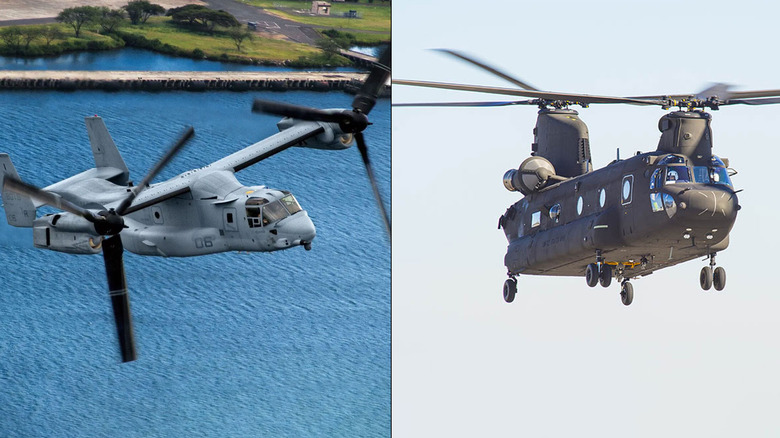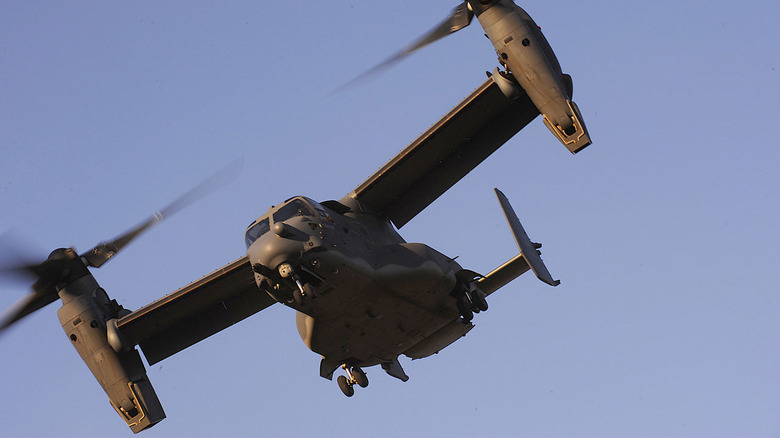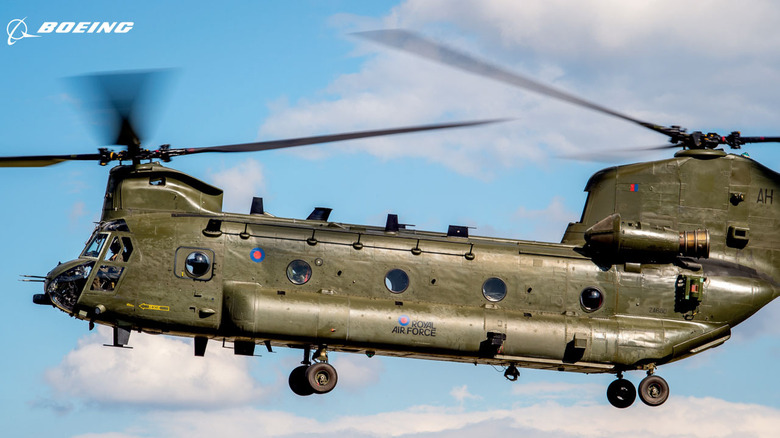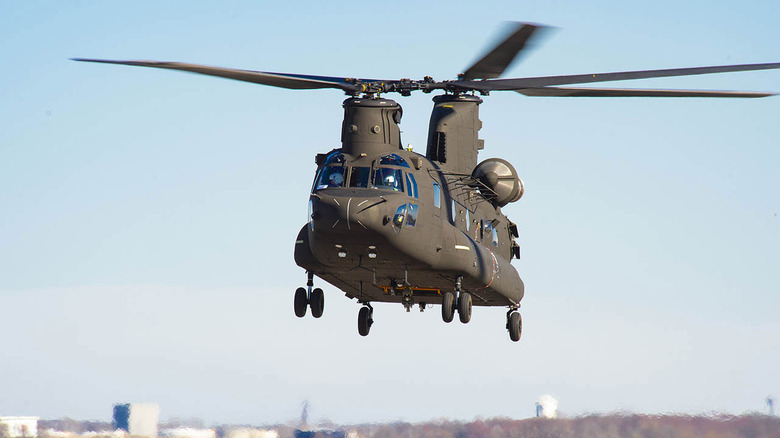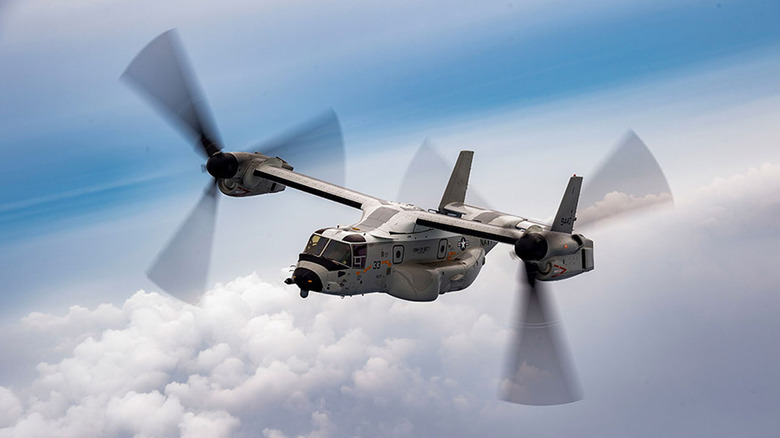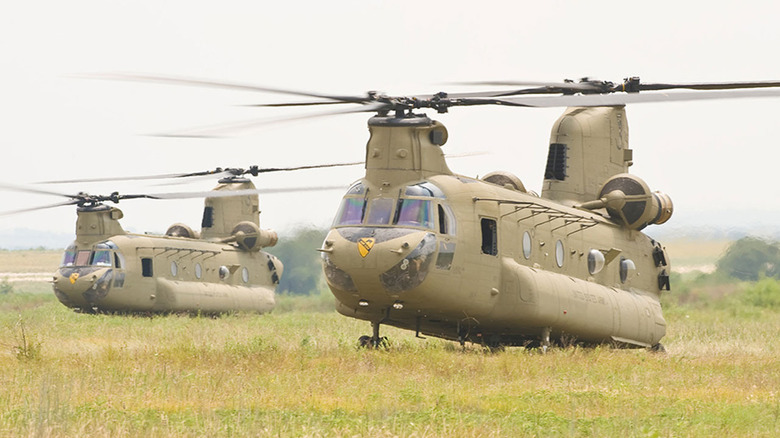V22 Osprey Vs CH47 Chinook: How Do They Compare?
Different branches of the United States military often utilize different vehicles and aircraft to serve similar purposes, leading to comparisons. The V-22 Osprey and CH-47 Chinook are two aircraft used by separate branches of the military that have drawn such comparisons, but both aircraft are quite different.
The V-22 Osprey is the closest thing in the United States Navy and Air Force to a full-on "Transformer" robot. Capable of shifting its rotor blades to achieve vertical and forward propulsion, the Bell and Boeing aircraft looks like it's pulled straight from a science fiction movie. However, just because it looks cool doesn't make it the superior aircraft.
Regardless of how innovative the V-22 Osprey is, the rugged durability and reliability of the famed CH-47 Chinook for the United States Army can't be understated. Though both aircraft are used for similar operations, they both have their strengths and weaknesses that make them unique.
The V-22 Osprey is an innovative aircraft
The V-22 Osprey is the only tiltrotor aircraft currently deployed by the United States Department of Defense (DoD). It is most notable for its ability to take off and land vertically, with rotating rotor blades that transform to propel the aircraft forward. Though incredibly innovative, the origins of the Osprey began over 30 years ago, in 1989, when the V-22 made its first flight in Arlington, Texas. Developed by a collaboration between Bell and Boeing, the V-22 Osprey serves as an assault support aircraft.
The United States Air Force, Marines, and Navy all use a variation of the V-22, with the Air Force's version, the CV-22, being a special operations variant of the USMC's MV-22 Osprey. The CV-22 variation of the aircraft reached operational capability in 2009, with the Marine's MV-22 replacing the CH-45 Sea Knight in 2007. The Navy uses the HV-22 for combat search and rescue and fleet logistics support. Today, the many variations of the V-22 have logged more than 700,000 flight hours, with a total of 472 V-22s manufactured.
In operations, the Osprey is utilized as a multi-role tool, as both a reliable method of transport in contested combat areas and a humanitarian instrument that can be used to rescue survivors of natural disasters or deliver life-saving supplies and equipment. The aircraft's speed and ability to convert into a fully vertical landing and takeoff enables it to fit in locations where other large planes wouldn't be able to land.
The CH-47 Chinook is durable and reliable
The CH-47 Chinook is arguably the most iconic and well-known heavy-lift platform utilized by American armed forces since the Chinook made its first flight in 1961. Developed by Boeing, this well-known cargo helicopter has been used in a variety of conflicts, from the Vietnam War to the conflicts in Afghanistan and Iraq.
Most well known for its ability to haul incredibly heavy loads, the Chinook can transport 36 fully-equipped troops as well as supplies and weapons using the sling cargo system that hangs underneath the helicopter. Everything from heavy artillery to humanitarian aid and supply can be lifted, with today's most modern iteration of the CH-47 helicopter capable of carrying 26,000 pounds in its sling.
Much like the V-22 Osprey, the CH-47 has been used in live combat zones to transport troops and supplies, but it has also been used in humanitarian relief efforts. Unlike the V-22, the Chinook is more of a traditional helicopter with a synchronized tandem rotor blade design.
V-22 Osprey and CH-47 Chinook hardware comparisons
The V-22 Osprey uses two Rolls-Royce Liberty AE1107C engines, with the special operations version, the CV-22, capable of reaching speeds up to 322 miles per hour. The latest version of the CH-47 uses dual Honeywell T55 engines and is capable of a maximum speed of 200 miles per hour, making the Osprey a faster aircraft overall.
That said, in the category of hauling capacity, the latest CH-47F Chinook is capable of hauling 16,000 pounds, excluding the sling capacity, while the Osprey is only capable of 10,000 pounds, making the Chinook a superior aircraft for hauling things like heavy artillery guns and supplies.
While both aircraft are used more for troop and supply transport and support efforts than a direct attack, both aircraft have variations that come with armaments capable of clearing out enemy infantry and vehicles.
The MV-22 has two weapons, including a belly-mounted GAU-17/A 7.62-millimeter six-barrel Gatling gun and an M240 7.62-millimeter machine gun on the Osprey's ramp. The CH-47D Chinook, on the other hand, comes with three M240 7.62-millimeter machine guns, making the firepower of both aircraft somewhat comparable.
The V-22 Osprey is controversial
Over the years, the V-22 Osprey has been at the center of controversy for several catastrophic crashes, with the most recent incident happening off the coast of Japan as recently as November 29, 2023, killing at least one pilot, with seven other crewmembers missing, according to reporting from Reuters. This is just the most recent crash in a long line of tragedies starting over two decades ago, with one crash in 2000 killing 19 Marines at the Marana Regional Airport.
Similar tragedies would happen over the years, with a 2012 training crash in the Moroccan military training area causing the death of two Marines, and several times after that, with at least 13 American troops killed within just the past two years. Crashes have been caused by a combination of human error and mechanical failure.
The worst technical issue cited is a "hard clutch engagement" problem that occurred in 2022. The issue caused the clutch to slip from its position momentarily before reengaging, damaging components in the propeller's rotor gearbox. Though the Marine Corps would report that the issue was fixed, it sadly led to the deaths of five Marines in a June 2022 crash.
The future of the CH-47 Chinook and V-22 Osprey
The CH-47 Chinook's reliability and effectiveness are widely recognized among the military, and the U.S. Army plans on deploying the helicopter well into the 2060s, with incremental improvements to the program over time. This means that the Chinook will see service in the U.S. military for 100 years, making it one of the oldest military helicopters still in service. According to Lt. Col. Ricard Bratt, "Our primary goal is maintaining the CH-47F's relevance to the warfighter."
On the other hand, the U.S. ended the purchase of V-22s in the 2023 DoD budget, with the last aircraft set to be delivered in 2026. The future of the aircraft remains unclear, though Bell and Boeing are both dedicated to continuing to provide support and parts for the existing aircraft.
Though it seems like the transforming tiltrotor aircraft that is the Osprey is the more advanced aircraft, it seems like the United States prefers the reliability of the two-bladed Chinook, lending itself to the old idiom, "If it ain't broke, don't fix it."
